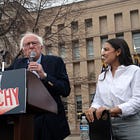SUMMER READING: The inside-outside game, part five
Can movement politics shape a presidency?
Representative Alexandria Ocasio-Cortez honed her approach in opposition. But the Biden administration would give her the chance to see whether she could influence the direction of a party in power — and if she couldn’t, whether the attempt would be worth the effort.
Today’s excerpt from The Persuaders: At the Front Lines of the Fight for Hearts, Minds, and Democracy — the conclusion of Anand’s profile of Ocasio-Cortez — details how she moved beyond the demands of gatekeepers on the left and critics on the right to push lifelong moderate Joe Biden to adopt some of the most progressive policy ideas since the New Deal, and what the attempt meant for her political future, and the country’s.
For our supporting subscribers, we have been presenting Anand’s profile of Representative Alexandria Ocasio-Cortez this week. For previous installments, click on the links below; read on for the final segment.
The inside-outside game, part five
Thus in the late spring and summer of 2020, Ocasio-Cortez pursued the kind of multitrack politicking that might have been hard for people less prone to world-straddling to understand. In interviews, she was cool to Biden, jettisoning the usual Washington custom of coming around to enthusiastic support of the nominee, whoever the nominee is. But when Sanders and Biden formed unity task forces to synthesize positions amenable both to the moderate faction that had won the election and to the progressive faction that had much of the party’s grassroots energy, Ocasio-Cortez was invited to join one—as the co-chair, alongside the former secretary of state John Kerry, of the climate task force. She was criticized by some on her left flank for capitulating to Team Biden. But she joined anyway, and a spokeswoman, Lauren Hitt, told reporters that Ocasio-Cortez would be “fully accountable” to climate activists and “believes the movement will only be successful if we continue to apply pressure both inside and outside the system.” One of her fellow task force members was Varshini Prakash, whom she had joined that day in the occupation of Pelosi’s office. Facing the same risks of friendly fire as Ocasio-Cortez, Prakash said publicly, “As I step onto this task force, I’m taking each and every member of our movement with me. I will fight as hard as I can for a platform that will do the most good for the most people.” And, by all accounts, this time, on this score, their gamble proved correct. Biden’s climate plan moved significantly. Noam Chomsky, a hero to many leftists, pronounced Biden’s new-and-improved climate plan to me as being “farther to the left than any Democratic candidate in memory” and “far better than anything that preceded it,” and “not because Biden had a personal conversion or the DNC had some great insight, but because they’re being hammered on by activists coming out of the Sanders movement and others.” Chomsky described Biden’s new plan as “largely written by the Sunrise Movement.”
In one of our conversations, I asked Ocasio-Cortez about the criticisms she received from the inside types about her activism and from the outside types about her capitulating to the game.
“No matter where you are on the political spectrum, the moral of coalition building is this idea that we need each other, especially when it comes to organizing around social change,” she told me. “Some people are of the belief that electoralism is the only vehicle that we have to enact change at any sort of broad level. Other people are of the belief that electoralism is broken beyond repair and it is a dead end when you look at the profound influence of dark money and X, Y, Z ways that American democracy is fragile, imperiled, or broken. The thing I keep coming back to is that it really isn’t one or the other. It’s that we need each other.
“There are certain things that can be accomplished electorally that simply cannot be done with grassroots organizing,” she continued. “There are some things that can be done with collective mass movement that will never be accomplished through electoral means. And, in fact, going beyond that binary, both of these types of work and organizing are necessary for the success of the other. Yet you still have hard-liners in both categories.”









